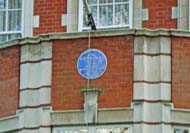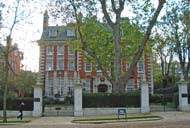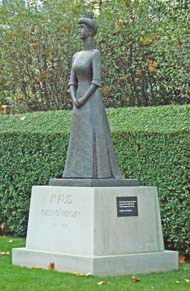Military, mental
At the beginning of WW1 Lord Knutsford (1855-1931), Chairman of the London Hospital House Committee, had been approached by various doctors who had told him that cases of neurasthenia had never been recognised as war-shock during the Boer War, and that this situation should never happen again. Lord Knutsford therefore approached the War Office to obtain a sanction to form his own committee to raise funds for a hospital for shell-shocked army officers. He stipulated that he should be allowed to manage this committee without interference or red tape.
He consequently made a public appeal to raise £10,000 to open the hospital. The executors of the late Lord Rendel generously allowed No. 10 Palace Green, a house built in 1905, to be used for the purpose.
Soon £11,780 had been subscribed and it was hoped that this would be enough to support the hospital for two years. Members of the public also donated useful items of furniture - a large round table for the hall, a Chesterfield couch and several deep-seated armchairs.
The building was adapted to hold 33 patients in separate rooms and the Special Hospital for Officers opened in January 1915, with Queen Alexandra and Princess Victoria making a private visit. The staff consisted of a Matron, 3 trained nurses and 3 probationers. The War Office referred patients suffering from functional neuroses, traumatic neurasthecia and the milder psychoses. However, the accommodation soon proved inadequate for the number of cases and in May a large mansion in Campden Hill, Moray Lodge, was also acquired. (By November, Latchmere House in Ham Common had also been acquired by the committee and opened as a special hospital, treating officers with severe psychoses.)
By June 1918 the house next door, 11 Palace Green, had also been taken over.
The Hospital continued to function until the 1920s under the control of the Ministry of Pensions.
In 1936 the building was let for use as the official residence of the Norwegian ambassador. During WW2 its dining room was used every Friday by King Haakon VII and his exiled Norwegian government to hold meetings of the Council of State. The table they sat around is still in use today.
In 1998 the Norwegian parliament renewed the lease of the Grade II listed building for another 80 years.
In 2005 a bronze statue of Queen Maud, daughter of King Edward VII and grand-daughter of Queen Victoria, who had become Queen of Norway in 1905, was unveiled in the front garden by King Harald of Norway. The ceremony was attended by Queen Elizabeth II and the Duke of Edinburgh, the Queen of Norway, the Crown Prince of Norway and Princess Astrid.
A blue plaque commemorating King Haakon, who led the Norwegian government-in-exile during WW2, was also unveiled.
No. 11 Palace Green appears to have
been demolished.

The entrance to Palace Green from Kensington High Street.

The blue plaque is on the left side of the front of the building (above).

10 Palace Green.

(Author unstated) 1915 Special Hospital for Officers. The Red Cross 2, 16.
(Author unstated) 1915 The Special Hospital for Officers. British Journal of Nursing, 16th January, 50-51.
Barham P 2007 Forgotten Lunatics of the Great War. Yale University Press.
http://bjp.rcpsych.org
http://rcnarchive.rcn.org.uk (1916)
http://rcnarchive.rcn.org.uk (1920)
http://viewfinder.english-heritage.org.uk
www.1914-1918.net
www.dennorskeklub.co.uk
www.kentvad.org
Return to home page